
RAF Hunsdon Dispersed Sites
Site 1 Communal.
Sited
off
of
the
St
Margarets
Road,
it
contained
31
buildings
and
serviced
the
everyday
type
of
domestic
needs
a
large
community
of
servicemen
required.
These
included
the
dental
unit(22)
The
Sergeants
Mess
(27)
Two
high
level
water
tanks
(8
&
9)
Cinema
that
seated
355
(29)
Dining
hall
and
cookhouse
for
820
(21)
10
blast
shelters,
1
Stanton
type
air
raid
shelter,
Barber
shop,
Tailor
at
the
requisitioned
Chesnut
Cottage
by
the
entrance
gate,
and
at
the
other
end
of
the
site
is
the
Sewerage
works.
These
are
still
in
place
and
working
for
the
village
of
Hunsdon
to
this
day.
Sadly
they
are
the only buildings left on the site, all of the others have been cleared. A large house now occupies the site where the Sergeants mess once was.
Site No2
A
site
for
All
ranks
and
included
Officers
of
21
buildings.
Sergeants
and
airmens
Barrack
huts.
Air
raid
shelters,
Ablutions,
Anti
gas
clothing
and
equipment store( Special clothing , masks and barrier ointment in case of enemy attack with either Mustard Gas or Phosgene Gas), latrines (toilets)
The
only
building
remains
found
here
are
the
base
for
the
Picket
hut
(1)
two
Stanton
type
air
raid
shelters
(ARS)
a
floor
base
for
the
Officers
latrines
(20) and partial foundation remains of a barrack hut (17)
The
comined
Gymnasium
and
Chapel
(32)
was
demolished
some
yeas
ago
and
a
new
house
built
in
its
place.
Photo
below
of
the
gymnasium
taken
in 1985.
Site No3
Just off of the St Margarets Road Opposite the 'Bonningtons' turning.
Again, a mixed ranks accomodation area with 21 buildings including Anti gas store, 4 Air Raid Shelters (Stanton types) Latrines and barrack huts.
All
four
Stanton
type
air
raid
shelters
(ARS)
remain
as
do
the
raised
brick
foundations
and
steps
to
several
of
the
barrack
huts,
and
the
remains
of
two
latrines.
Site 4 Fillets Farm.
Mixed rank accomodation area for Officers , Sergeants and airmen of 33 buildings. Anti Gas store, 5 ARS Picket post, ablutions and latrines.
Apart from three Stanton type air raid shelters, nothing else remains.
Site 5
East of Fillets Farm.
Sergeant and Airmens accomodation area of 20 buildings and three ARS. Nothing remains of this site apart from a mound of rubble.
Site 6
South of Fillets farm and West of the St Margarets Road.
Mixed
(all
Ranks)
accomodation
area
of
33
buildings,
5
ARS,
latrines
,
Anti
Gas
store,
Drying
rooms,
barrack
huts.
Totally
eradicated,
apart
from
a
previously unknown of hut foundation and signs of rubble, a single drainage inspection manhole under thick bushes in the corner of the site.
Site 7
West of St Margarets Road and on the left hand side of the lane that leads to Fillets Farm. One of the largest mixed rank barrack sites containing 17
huts, each one for twelve persons.
Latrines, drying rooms , ablutions and 4 ARS. site again has been totally eradicated from the landscape with no trace remaining.
Site 8
Situated
at
Hunsdonbury,
this
has
the
most
buildings
remaining
in
situ.
The
site
was
for
WAAFs
and
had
six
barrack
huts
for
21
persons
and
a
single
one
for
18.
Dining
hall
for
300
persons,
Station
sick
quarters
for
150,
Equipment
Section
and
offices,
Sports
Store,
Gardeners
cottage,
Institute
for
300 persons, Bath house, Boiler house, Decontamination block and Latrines.
Of
these
the
base
for
the
Institute
remains
in
amongst
now
mature
trees,
6
Barrack
huts
of
BCF
type
remain
along
with
a
small
high
level
water
tank.
The
site
is
strictly
private.
The
Coach
House
was
requisitioned
for
the
Equipment
Section
and
remains
to
this
day
as
a
private
residence.
The
photo
below shows the personel of the section outside the Coach house in 1943.
The
living
and
domestic
parts
of
the
airfield
are
referred
to
as
Dispersed
sites.
The
description
means
just
that,
dispersed
away
from
the
main
airfield
in
case
of
air
attack.
All
of
these
sites
had
their
own
air
raid
shelters
and
ablutions
(toilets
and
washing
)
Anti-gas
equipment
stores,
M&E
(Mechanical
and Electrical plinths for power) The sites were for Officers NCO's and Airmen.
WAAF's or to give them their proper name, the Womens Auxilliary Air Force had their own site at Hunsdonbury.












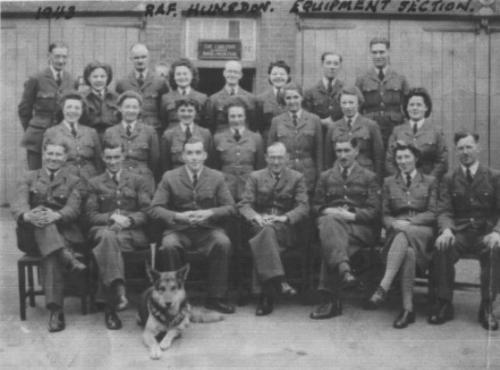
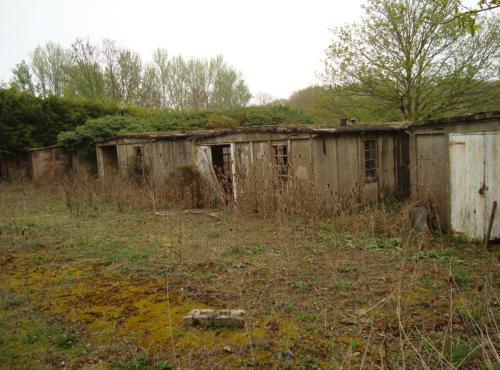
Wartime Airfields
rjkdesign
Wartime Airfields
rjkdesign


Wartime Airfields
Wartime Airfields


Site 1
Communal.
Sited
off
of
the
St
Margarets
Road,
it
contained
31
buildings
and
serviced
the
everyday
type
of
domestic
needs
a
large
community
of
servicemen
required.
These
included
the
dental
unit(22)
The
Sergeants
Mess
(27)
Two
high
level
water
tanks
(8
&
9)
Cinema
that
seated
355
(29)
Dining
hall
and
cookhouse
for
820
(21)
10
blast
shelters,
1
Stanton
type
air
raid
shelter,
Barber
shop,
Tailor
at
the
requisitioned
Chesnut
Cottage
by
the
entrance
gate,
and
at
the
other
end
of
the
site
is
the
Sewerage
works.
These
are
still
in
place
and
working
for
the
village
of
Hunsdon
to
this
day.
Sadly
they
are
the
only
buildings
left
on
the
site,
all
of
the
others
have
been
cleared.
A
large
house
now
occupies
the
site
where the Sergeants mess once was.
Site 2
A
site
for
All
ranks
and
included
Officers
of
21
buildings.
Sergeants
and
airmens
Barrack
huts.
Air
raid
shelters,
Ablutions,
Anti
gas
clothing
and
equipment
store(
Special
clothing,
masks
and
barrier
ointment
in
case
of
enemy
attack
with
either
Mustard
Gas
or
Phosgene
Gas),
latrines
(toilets)
The
only
building
remains
found
here
are
the
base
for
the
Picket
hut
(1)
two
Stanton
type
air
raid
shelters
(ARS)
a
floor
base
for
the
Officers
latrines (20) and partial foundation remains of a barrack hut (17)
The
comined
Gymnasium
and
Chapel
(32)
was
demolished
some
yeas
ago
and
a
new
house
built
in
its
place.
Photo
below
of
the
gymnasium
taken in 1985.
Site No3
Just
off
of
the
St
Margarets
Road
Opposite
the
'Bonningtons'
turning.
Again,
a
mixed
ranks
accomodation
area
with
21
buildings
including
Anti
gas
store,
4
Air
Raid
Shelters
(Stanton
types)
Latrines
and
barrack huts.
All
four
Stanton
type
air
raid
shelters
(ARS)
remain
as
do
the
raised
brick
foundations
and
steps
to
several
of
the
barrack
huts,
and
the
remains of two latrines.
Site 4
Fillets Farm.
Mixed
rank
accomodation
area
for
Officers
,
Sergeants
and
airmen
of
33
buildings.
Anti
Gas
store,
5
ARS
Picket
post,
ablutions
and
latrines.
Apart
from
three
Stanton
type
air
raid
shelters,
nothing
else
remains.
Site 5
East of Fillets Farm.
Sergeant
and
Airmens
accomodation
area
of
20
buildings
and
three
ARS. Nothing remains of this site apart from a mound of rubble.
Site 6
South of Fillets farm and West of the St Margarets Road.
Mixed
(all
Ranks)
accomodation
area
of
33
buildings,
5
ARS,
latrines
,
Anti
Gas
store,
Drying
rooms,
barrack
huts.
Totally
eradicated,
apart
from
a
previously
unknown
of
hut
foundation
and
signs
of
rubble,
a
single
drainage
inspection
manhole
under
thick
bushes
in
the
corner of the site.
Site 7
West
of
St
Margarets
Road
and
on
the
left
hand
side
of
the
lane
that
leads
to
Fillets
Farm.
One
of
the
largest
mixed
rank
barrack
sites
containing 17 huts, each one for twelve persons.
Latrines,
drying
rooms
,
ablutions
and
4
ARS.
site
again
has
been
totally eradicated from the landscape with no trace remaining.
Site 8
Situated
at
Hunsdonbury,
this
has
the
most
buildings
remaining
in
situ.
The
site
was
for
WAAFs
and
had
six
barrack
huts
for
21
persons
and
a
single
one
for
18.
Dining
hall
for
300
persons,
Station
sick
quarters
for
150,
Equipment
Section
and
offices,
Sports
Store,
Gardeners
cottage,
Institute
for
300
persons,
Bath
house,
Boiler
house, Decontamination block and Latrines.
Of
these
the
base
for
the
Institute
remains
in
amongst
now
mature
trees,
6
Barrack
huts
of
BCF
type
remain
along
with
a
small
high
level
water
tank.
The
site
is
strictly
private.
The
Coach
House
was
requisitioned
for
the
Equipment
Section
and
remains
to
this
day
as
a
private
residence.
The
photo
below
shows
the
personel
of
the
section outside the Coach house in 1943.
The
living
and
domestic
parts
of
the
airfield
are
referred
to
as
Dispersed
sites.
The
description
means
just
that,
dispersed
away
from
the
main
airfield
in
case
of
air
attack.
All
of
these
sites
had
their
own
air
raid
shelters
and
ablutions
(toilets
and
washing
)
Anti-
gas
equipment
stores,
M&E
(Mechanical
and
Electrical
plinths
for
power) The sites were for Officers NCO's and Airmen.
WAAF's
or
to
give
them
their
proper
name,
the
Womens
Auxilliary
Air Force had their own site at Hunsdonbury.

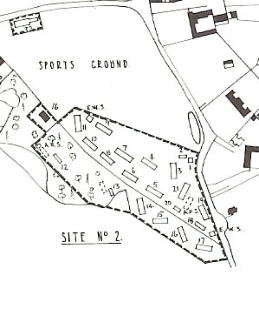






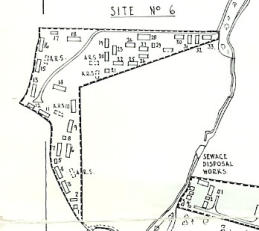
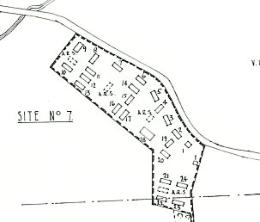
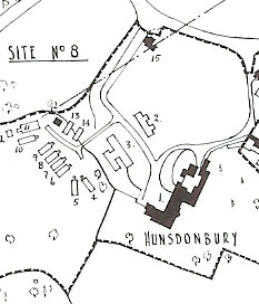



rjkdesign













